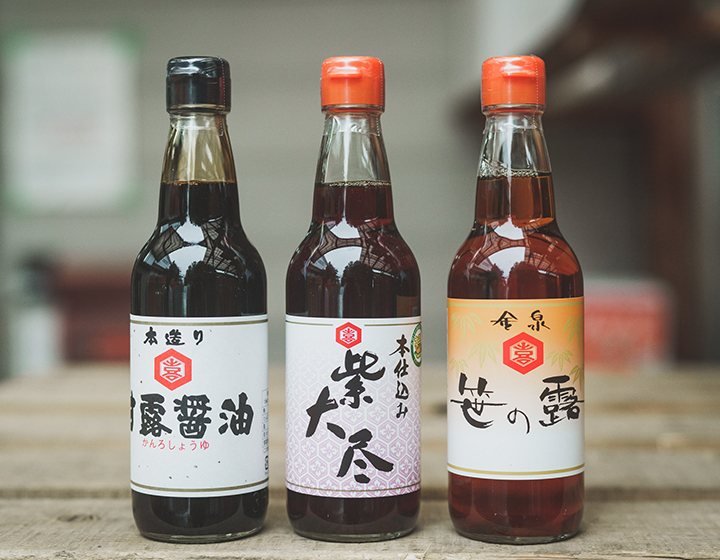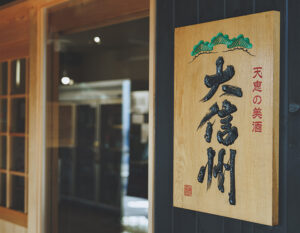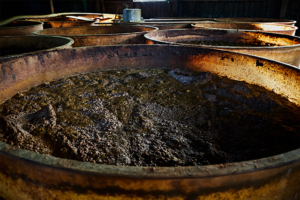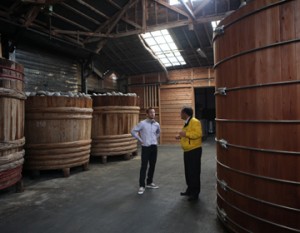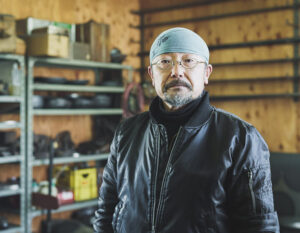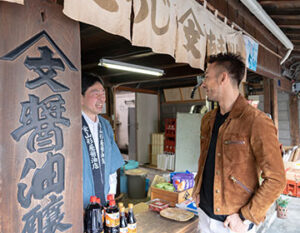Okubo Brewery, located in Matsumoto City, Nagano Prefecture, is a soy sauce brewery that enjoys great support not only from its hometown in Shinshu, but also from famous soba noodle stores throughout Japan, from Hokkaido in the north to Kyushu in the south. Because of its popularity, many soba shops go to the trouble of putting up signs in their stores to emphasize that they use Okubo Brewery’s soy sauce as kaeshi (a seasoning for buckwheat noodles).
In 2021, Okubo Brewery won the “Omotenashi Selection,” an award established to discover and promote to the world Japan’s excellent products and services with a spirit of hospitality, The product was awarded the Gold Prize, beating out a host of superior products from all over Japan. This proves that Okubo Brewery can not only distribute its products to restaurants, but also compete with major grocery stores around the world, attracting even more attention. What kind of soy sauce production is Okubo Brewery aiming for as the leading brewery in Nagano Prefecture?
Individuality” created by tracing technology that has continued since the Meiji era
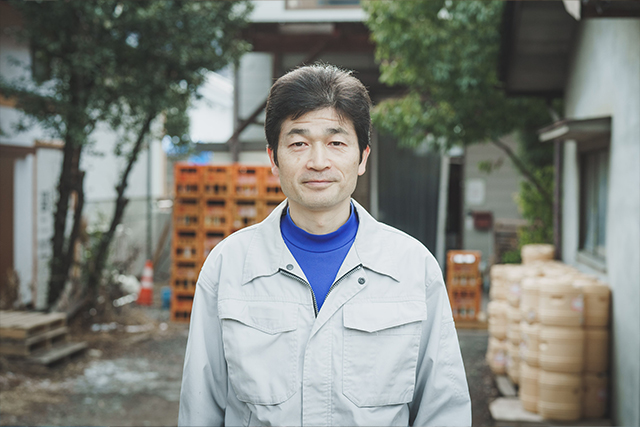
Okubo Brewery was established in 1905. As mentioned above, the soy sauce produced here is highly trusted by famous restaurants and cookery researchers. Katsumi Okubo, the fourth generation of the brewery’s family and the senior managing director, is still faithfully following the methods of his predecessors, even though he now plays a central role in the brewing process himself. The best example of this is the naturally brewed soy sauce, which is prepared in wooden vats.
The wooden vats that line the brewing room are old vats that have been used for generations. Stainless steel tanks, which are more common today, are more stable in taste and easier to manage and clean. However, Mr. Okubo insists on continuing to use wooden vats. The reason for this is the characteristics of wood, such as respiration and the bacteria that live in the vat. This is the factor that gives the flavor character and depth. Of course, unlike stainless steel tanks, wood is a natural material, so it is important to take care of it.
Katsumi’s father, Bunyasu, the president of the brewery, takes care of the wooden vats used in the brewery by lacquering them himself. There are 10 wooden vats, each more than twice his own height. It is hard work just to paint one vat, but even so, he says it is an essential part of his job to maintain the natural brewing process. This attitude toward work and behavior can be felt not only in the care of the wooden vats, but everywhere in the brewery. The cleanliness and well-maintained lines of communication that contradict the quaintness of the brewery are just one example of the daily attention to quality in areas other than brewing techniques.
Making the most effective use of the limited site
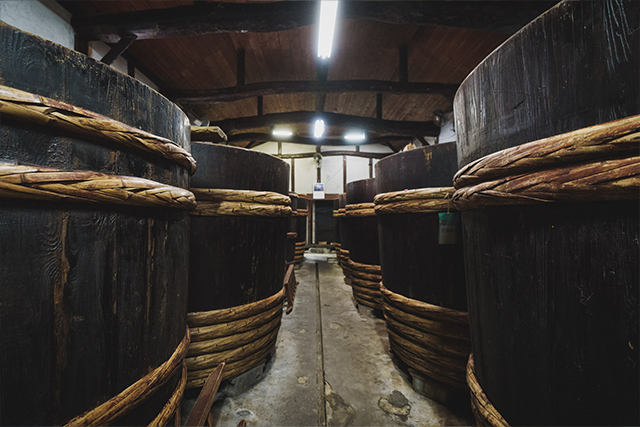
Katsumi, the fourth generation of the brewery owner, while giving a tour of his own brewery, said, “Our brewery doesn’t have much to offer in terms of appearance. It has been repeatedly expanded to its current form. He is modest. Indeed, some of the storehouses have a quaint atmosphere, while others are lined with large industrial machines. This is the result of his predecessor Bunyasu’s efforts to update his own brewery on a limited site, while preserving the good traditions built up over generations, and how to brew efficiently.
Soybeans and wheat are brought up from the material storehouse and processed on the third floor, then brought down to the second floor where the koji room is located, and further down to the wooden vats waiting on the first floor where they are prepared. It is a model of how to make soy sauce in a limited space. What really caught my attention were the two devices hanging from the ceiling on the third floor that pour roasted wheat into the koji making tanks. One might ask why separate machines are needed to pour the same wheat into different tanks, but the reason is said to be ease of mixing.
Wheat is the raw material for the koji making process, which is an important step in the production of soy sauce. The wheat is roasted and then ground, and the difference in the size of the wheat is more important than the uniformity of the size of the wheat, because it mixes better. The design of the machine is such that the ground wheat is moved along the rail right above the koji making tank, but the structure is such that the two machines switch conductors so that they do not obstruct each other’s paths on the rail. This is an original idea of Mr. Bunyasu’s, based on the switching structure of the rail track. By creating an efficient work flow, the brewery is able to minimize waste in the production process and use the extra resources for better soy sauce production.
Attention to Ingredients
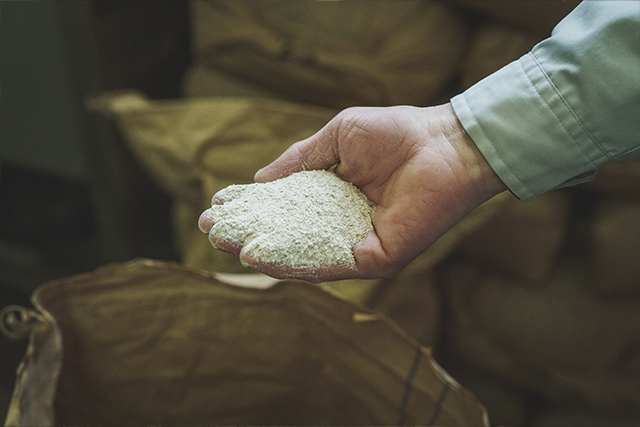
In addition to the natural brewing process, which uses wooden vats to mature the soy sauce over a long period of time, and the use of koji mold to add fullness to the flavor, Okubo Brewery is also very particular about the ingredients it uses.
Wheat is grown in the prefecture. For salt, they use Shimamasu, which has a high mineral content and no salt angle. Of course, Okubo Brewery is very particular about its soybeans. The soybeans are purchased directly from a farmer in Aomori Prefecture named Takezo Fukushi. Although the name “Aomori” may not sound familiar, the quality of these soybeans, which are grown organically without pesticides and sown directly in the fertile soil of the Tohoku region without water, is evident from the moment the beans are washed.
The quality of the soybeans is such that even Mr. Okubo, who has seen and tasted many soybeans in his life, says, “These are beans that make you fall in love with them. Since encountering these soybeans, he feels that the reputation of soy sauce has improved even further. Whether it is these soybeans or the aforementioned wheat and salt, Katsumi is a firm believer in using only ingredients whose producers’ faces can be seen. This commitment is reflected in the high quality of his soy sauce.
Good Soy Sauce Production Starts with Environmental Considerations
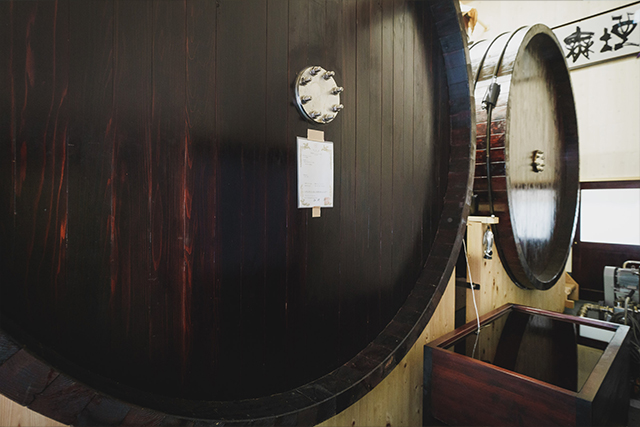
Along with brewing techniques and ingredients, Okubo Brewery is also particular about one other thing. That is environmental friendliness. Soy sauce is made by the power of nature, including microorganisms, so Okubo-san and his son believe that it is important to keep “nature,” which is the source of soy sauce, beautiful.
Bunyasu-san has been using a deposit system since the 1960s, whereby he receives a deposit from his first customer and reuses the bottles. This is not only in the neighborhood, but anywhere in the country. By collecting bottles in this way instead of disposing of them at the place of shipment, he is helping to preserve the environment. Of course, what we can do on our own may be trivial. But it is better than nothing.
We believe that small steps are important in everything, and we have continued to do so until today. Now, Bunyasu’s philosophy has been taken over by Katsumi, who has begun to weave a new tradition at Okubo Brewery.



